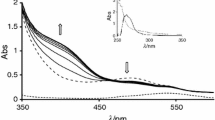Abstract
The complex formation of Cd(II) with N-donor ligands in dimethylsulfoxide (DMSO) is investigated by means of potentiometry and titration calorimetry. The ligands considered in this work are tripodal polyamines and polypyridines: 2,2′,2″-triaminotriethylamine (TREN), tris(2-(methylamino)ethyl)amine (Me3TREN), tris(2-(dimethylamino)ethyl)amine (Me6TREN), tris[(2-pyridyl)methyl]amine (TPA) and 6,6′-bis-[bis-(2-pyridylmethyl)aminomethyl]-2,2′-bipyridine (BTPA). These ligands are characterized by a systematic modification of the donor groups to relate their structure to the thermodynamics of the complexes formed. The TREN and Me3TREN ligands form highly stable species. The stability of the complex formed with the fully methylated Me6TREN is much lower than with other polyamines and the enthalpic and entropic terms suggest an incomplete coordination to the metal ion. In general, the TPA ligand forms complexes less stable than TREN and Me3TREN as a result of the combination of higher structural rigidity of TPA and lower basicity of pyridine moiety with respect to primary and secondary amines. Pyridine-containing ligands display, in general, a less unfavorable formation entropy than tripodal polyamines here considered. In particular, TPA forms a more stable 1:1 species with respect to Me6TREN due to the entropic term, being the enthalpy less negative. The ligand BTPA is able to form only a monometallic complex, where the metal ion is likely to be encapsulated as indicated by the obtained thermodynamic parameters.





Similar content being viewed by others
References
Bazzicalupi C, Bencini A, Bianchi A, Danesi A, Faggi E, Giorgi C, Santarelli S, Valtancoli B. Coordination properties of polyamine-macrocycles containing terpyridine units. Coord Chem Rev. 2008;252:1052–68.
Williams NJ, Gan W, Reibenspies JH, Hancock RD. Possible steric control of the relative strength of chelation enhanced fluorescence for zinc(II) compared to cadmium(II): metal ion complexing properties of tris(2-quinolylmethyl)amine, a crystallographic, UV-visible, and fluorometric study. Inorg Chem. 2009;48:1407–15.
Bazzicalupi C, Bencini A, Berni E, Bianchi A, Borsari L, Giorgi C, Valtancoli B, Lodeiro C, Lima JC, Parola AJ, Pina F. Protonation and coordination properties towards Zn(II), Cd(II) and Hg(II) of a phenanthroline-containing macrocycle with an ethylamino pendant arm. Dalton Trans. 2004;591–97.
Bravard F, Rosset C, Delangle P. Cationic lanthanide complexes of neutral tripodal N,O ligands: enthalpy versus entropy-driven podate formation in water. Dalton Trans. 2004;2012–18.
Dossing A, Toftlund H, Hazell A, Bourassa J, Ford PC. Crystal structure, luminescence and other properties of some lanthanide complexes of the polypyridine ligand 6,6′-bis[bis(2-pyridylmethyl) aminomethyl]-2,2′-bipyridine. J Chem Soc Dalton Trans. 1997;335–39.
Bazzicalupi C, Bencini A, Bianchi A, Danesi A, Giorgi C, Valtancoli B. Anion binding by protonated forms of the tripodal ligand tren. Inorg Chem. 2009;48:2391–8.
Roundhill MD. Extraction of metals from soil and waters. New York: Kluwer; 2001.
Rydberg J, Cox M, Musikas C, Choppin GR. Solvent extraction principles and practice, revised and expanded. New York: Dekker; 2004.
Jal PK, Patel S, Mishra B. Chemical modification of silica surface by immobilization of functional groups for extractive concentration of metal ions. Talanta. 2004;62:1005–28.
Comuzzi C, Melchior A, Polese P, Portanova R, Tolazzi M. Cobalt(II) complexes with nitrogen donors and their dioxygen affinity in dimethyl sulfoxide. Eur J Inorg Chem. 2002;2194–201.
Comuzzi C, Grespan M, Melchior A, Portanova R, Tolazzi M. Thermodynamics of complexation of cadmium(II) by open-chain N-donor ligands in dimethyl sulfoxide solution. Eur J Inorg Chem. 2001;3087–94.
Dossing A, Engberg P, Hazell R. Syntheses and structure of dinuclear cobalt(II) complexes of the polypyridine ligand 6,6′-bis[bis(2-pyridylmethyl)aminomethyl]-2,2′-bipyridine. Inorg Chim Acta. 1998;268:159–62.
Icke RN, Wisergarver BB, Allies GB. β-Phenylethyldimethylamine. Org Synth. 1945;25:89–91.
Anderegg G, Wenk F. Pyridinderivate Als Komplexbildner VIII. Die Herstellung Je Eines Neuen Vier- Und Sechszähnigen Liganden. Helv Chim Acta. 1967;50:2330–2.
Dossing A, Hazell A, Toftlund H. Crystal structures of dinuclear copper(II) and oxovanadium(IV) complexes of N,N,N,N′-tetrakis(2-pyridylmethyl)-6,6′-bis(aminomethyl)-2,2′-bipyridine. Acta Chem Scand. 1996;50:95–101.
Gans P, Sabatini A, Vacca A. Investigation of equilibria in solution. Determination of equilibrium constants with the HYPERQUAD suite of programs. Talanta. 1996;43:1739–53.
The IUPAC Stability Constants Database, Ver. 5.82. Academic Software, UK.
Gans P, Sabatini A, Vacca A. Simultaneous calculation of equilibrium constants and standard formation enthalpies from calorimetric data for systems with multiple equilibria in solution. J Solut Chem. 2008;37:467–76.
Anderegg G, Gramlich V. 1/1 Metal-complexes of bivalent cobalt, nickel, copper, zinc, and cadmium with the tripodal ligand tris[2-(dimethylamino)ethyl]amine—their stabilities and the X-ray crystal-structure of its copper(II) complex sulfate. Helv Chim Acta. 1994;77:685–90.
Anderegg G, Hubmann E, Podder N, Wenk F. Pyridinderivate Als Komplexbildner. XI. Die Thermodynamik Der Metallkomplexbildung Mit Bis-, Tris- Und Tetrakis[(2-Pyridyl)Methyl]-Aminen. Helv Chim Acta. 1977;60:123–40.
Ciampolini M, Paoletti P. Five-coordinated high-spin complexes of cobalt(II) iodide and thiocyanate with 2,2′,2″-triaminotriethylamine. Inorg Chem. 1967;6:1261–2.
Comuzzi C, Melchior A, Polese P, Portanova R, Tolazzi M. Thermodynamics of complex formation of silver(I), cadmium(II) and cobalt(II) with open-chain polyamines in dimethyl sulfoxide and molecular dioxygen binding to cobalt(II) complexes. Eur J Inorg Chem. 2003;1948–55.
Klufers P, Mayer P. A star-shaped heptanuclear tetramine cadmium(II) complex. Acta Cryst Sect C. 1998;54:722–5.
Meyerstein D. Are M-N bonds indeed inherently weaker when N is a tertiary rather than a primary or secondary nitrogen atom? Coord Chem Rev. 1999;186:141–7.
Ahrland S. Solvation and complex formation—competing and cooperative processes in solution. Pure Appl Chem. 1982;54:1451–68.
Del Piero S, Di Bernardo P, Fedele R, Melchior A, Polese P, Tolazzi M. Affinity of polypyridines towards Cd-II and Co-II ions: a thermodynamic and DFT study. Eur J Inorg Chem. 2006;3738–45.
Bebout DC, Stokes SW, Butcher RJ. Comparison of heteronuclear coupling constants for isostructural nitrogen coordination compounds of 111/113Cd and 199Hg. Inorg Chem. 1999;38:1126–33.
Brady C, Callaghan PL, Ciunik Z, Coates CG, Dossing A, Hazell A, McGarvey JJ, Schenker S, Winkler H, Wolny JA. Molecular structure and vibrational spectra of spin-crossover complexes in solution and colloidal media: resonance Raman and time-resolved resonance Raman studies. Inorg Chem. 2004;43:4289–99.
Acknowledgements
The authors are grateful to Prof. Anders Døssing (Department of Chemistry, University of Copenhagen, Denmark) for providing the BTPA ligand.
Author information
Authors and Affiliations
Corresponding author
Rights and permissions
About this article
Cite this article
Melchior, A., Tolazzi, M. & Piero, S.D. Thermodynamic study of Cd(II) complex formation with tripodal N-donor ligands in DMSO. J Therm Anal Calorim 103, 35–40 (2011). https://doi.org/10.1007/s10973-010-1002-7
Published:
Issue Date:
DOI: https://doi.org/10.1007/s10973-010-1002-7



